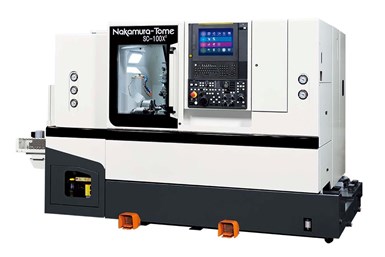Nakamura-Tome SC-100X2 Optimized for Complex Part Production
Turn-mill is designed to reduce cycle times and cost per piece with superimposed machining.

The SC-100X2 automatically unloads the workpiece once complete, minimizing manual intervention and downtime. Photo Credit: Methods Machine Tools
Methods Machine Tools’ Nakamura-Tome SC-100X2 is a twin-turret, multitasking machine which utilizes two tools on either side of the upper turret for superimposed machining, making it well suited for Swiss-type parts larger than 25 mm in diameter.
Operators can also use the upper and lower turret simultaneously, turning the machine into a true twin spindle/twin turret machine, providing more ways to solve complex machining problems.
The machine’s design contributes to faster cycle times compared to other machining processes, the company says. The SC-100X2 automatically unloads the workpiece once complete, minimizing manual intervention and downtime. When the machine completes a cycle, the parts catcher grips the part and places it on a conveyor, removing it from the machining environment.
It is said Nakamura-Tome’s user-friendly software enables users to program superimposed and multiturret jobs as easily as single-turret operations, all accessible from a FANUC 0i-TF Plus control. The software package also includes features such as the NT-Nurse system, NT- Smart Sign, NT-Navigator, oscillation turning and thermal compensation artificial intelligence.
Related Content
-
Video Tech Brief: Live-Tool, Y-Axis CNC Lathe with a Compact Footprint
This small footprint, big-bore lathe offers a generous work envelope. The addition of Y-axis and live tooling enables milling, drilling and tapping for increased machine capabilities.
-
A Mill-Turn’s Value for Machining Micro Gears
This leading manufacturer of non-lubricated robotic gears uses a seven-axis turn-mill to machine components from “amorphous” metals such as bulk metallic glasses.
-
OEM Moves From Automation Implementation to Refinement
Automating challenging parts for full-weekend automation requires substantial process refinements that can significantly boost throughput.






.jpg;maxWidth=300;quality=90)

.jpg;maxWidth=300;quality=90)



